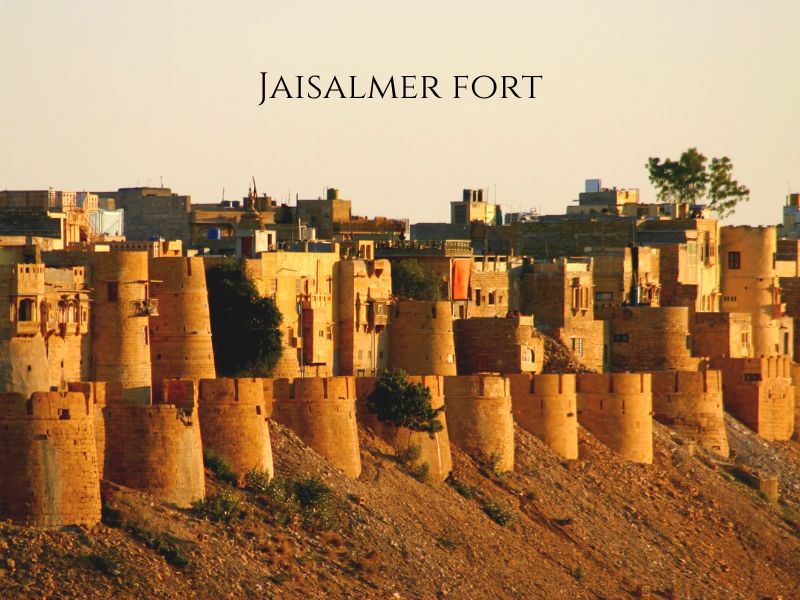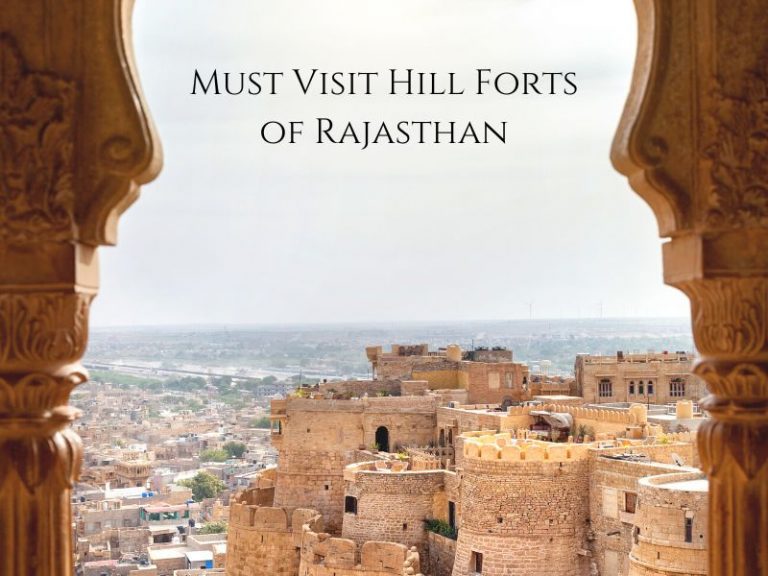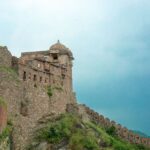Rajasthan, aptly dubbed as the “Land of Kings,” is also the biggest state in the Indian Republic. Rajasthan, formerly known as Rajputana, was divided into a number of regions, each of which was ruled by a different clan. Notable clans in this regard include the Meenas, Gurjars, Rajputs, and Jats, who built the state of Rajasthan as well as many of the historical monuments that now serve as the basis for the state’s rich cultural heritage. The many hill forts, many of which are located in the Aravalli Mountain Range and were constructed between the fifth and seventeenth centuries AD, are the monuments of the utmost importance. The Rajasthani Hill forts, which have long been architectural marvels, have served as homes for the rich cultural legacy of the Princely Clans that produced them. Perhaps though it would be impossible to name every hill fort in the state, the ones listed below will undoubtedly hold your attention for weeks or even months.
1. Chittorgarh Fort


It was built by the Mauryans in the seventh century AD and was given the name Chitrangada Mori in honour of the Maurya Ruler. It is the biggest fort in India. Later, it was governed by the Rajput Sisodiya clan. The fort, which stands at a height of 590.06 feet and covers an area of 691.09 acres, was invaded by Emperor Akbar in 1567 and placed under siege until it was finally abandoned in 1568. Prior to Maharaja Udai Singh II leaving the fort in 1559 to establish a more secure headquarters in Udaipur after losing to Akbar, Chittorgarh served as the seat of the Mewar kingdom. There are seven gates in all, including Pandan Pol, Bhairon Pol, Hanuman Pol, Ganesh Pol,Jodla Pol, Laxman Pol, and the Ram Pol, which is the biggest gate. The fort is an excellent example of the magnificent construction from the Maurya era. The Vijay Stambh, Kirti Stambh, Fatah Prakash Palace, Rana Kumbha Palace, Gaumukh Reservoir, and Padmini’s Palace are just a few of the historical landmarks that can be found inside the fort. In addition to this, the fort is home to other temples honouring various Hindu deities. The fort is a “must visit” tourist destination in Rajasthan and is indicative of the rich culture of Rajasthan, which is too extensive to be covered in a short piece like this.
2. Amber Fort


The Amber Fort, often known as Amber, is situated in the Amer town, 11 kilometres from Jaipur. The Kachwaha Rajput clan’s Maharaja Man Singh erected it in 1592 AD on the remains of an older edifice, and his successor Maharaja Jai Singh I extended it. The building underwent various renovations over the following 150 years until the founding of Jaipur as the new capital city in 1727 by the then-ruler Maharaja Sawai Jai Singh II. The first courtyard, also known as the “Jaleb Chowk,” was where troops would congregate and where numerous parades would take place. It also has a beautiful shrine known as the Shila Mata. This enormous fort comprises a total of four courtyards , and millions of people still visit it. The “Diwan-Ai-Aam,” or public gatherings, were held in the second courtyard, which has an elevated platform with 27 colonnades that each support galleries in the shape of elephants above them. The Maharajas’ private quarters are located in the third courtyard, which also contains the Mughal Gardens, the Tripolia gate, the Lion gate, and the Sheesha mahal, also known as the mirror palace and a stunning example of Rajput and Mughal architecture. The Queen, courtesans, and other women used to reside in the fourth courtyard, which is now empty. One of Rajasthan’s major tourist destinations is the Amer fort, which receives an astounding 5000 visitors each day and is home to a dazzling array of cultural artefacts.
3. Mehrangarh Fort


When the 15th Rathore Rajput king Maharaja Rao Jodha Singh chose to shift the capital of Marwar to Jodhpur after realising that the 1,000-year-old Mandore Fort was no longer a secure site, he erected the foundations for this impenetrable Citadel of Mehrangarh in 1459. The fort, which is 400 feet above Jodhpur and enclosed by high, impenetrable walls, is home to several palaces and courtyards that are outstanding examples of Rajputana style architecture. The fort contains seven gates, four of which are very significant historically since the clan’s rulers constructed them to commemorate the clan’s numerous triumphs. The Moti Mahal, the Pearl Palace, the Sheesha Mahal, the Hall of Mirrors, and the Raj Mahal are four noteworthy period apartments in the fort.Takhat Vilas, or Maharaja Takhat Singh’s Chamber, and Phool Mahal, or The Palace of Flowers. In addition to these, the fort has a museum with multiple galleries that feature a variety of artefacts, an armoury, and countless paintings of the Rathore kings and their numerous conquests. The Chamunda Mataji Temple, the royal family’s current chosen deity, is one of the fort’s main draws. Rao Jodha carried the idol there from Mandore, the former capital, and most Jodhpur residents worship it. The magnificent city of Jodhpur’s Mehrangarh Fort is one of its top tourist destinations. Although it is not on the UNESCO list of world heritage sites with Rajasthani forts, the fort’s rich history, stunning architecture, andIt is impossible to ignore the historic significance it contains.
4. Jaigarh fort


Built in the year 1726 by the Kachwaha Rajput king Maharaja Sawai Jai Singh II, the Amer fort is 400 feet above the hilltop known as “Cheel ka teela” or the hill of eagles. The palace complex is made up of four courtyards: Laxmi Vilas, Lalit Mandir, Vilas Mandir, and Aram Mandir. It also has a well-kept garden where the royal family once lived for a long time. The palace was built to protect the Amer Fort and was named after the king. Its design is similar to that of the Amer fort. The fort also housed an armoury, a cannon factory, and a museum with several artefacts and works of art that belonged to the warriors, whose assembly hall was known as the Subhat niwas. There are two temples in the fort dedicated to the royal family: the Kal Bhairav Temple from the 12th century and the Ram Harihar Temple from the 10th century. The fort includes a remarkable water collecting system that spans a distance of 4 kilometres. The water was kept in 3 subterranean reservoirs, the greatest of which had a capacity of up to 6 million gallons. The Jaivana cannon, the biggest gun on wheels in the world and one of the most important artefacts kept by the Citadel, was created in 1720 in the fort’s own foundry. was only ever tested once with a charge of 100 kilogrammes of gunpowder and a 50 kilogramme projectile, and it is reported to have travelled a distance. However, it was never fired in war. 35 kilometres away from the town of Chaksu, and the impact, according to many, was strong enough to cause a depression, which led to the formation of a pond that is still visible today.
5. Ranthambore fort


The Nagil Jats built the citadel in 944 AD, raising it 700 feet above the surrounding plain to make the area suitable for defence against invaders. At the time, Raja Sajraj Veer Singh Nagil was the ruler of Ranthambore. Up until the Chauhans and subsequently the Sultans took control of the fort in 1301, the Nagil Jats repeatedly occupied it. Before Akbar’s Mughal invasion, the territory was ruled by a number of different regional rulers, including the Mewar Rajputs and Sultan Bahadur Shah. Then it came under the control of the Kachwaha Rajput family, and the surrounding areas served as hunting grounds for the royal family up until India’s independence in 1947.The fort’s walls enclose an area of about 4 kilometres, and it also has a number of temples that date back to the 12th century. The fort was built using stone from mines that were later converted into water storage ponds. A must-see location for everyone who travels to Ranthambore.
6. Jaisalmer fort


The Bhati Rajput ruler Rao Jaisal constructed the Jaisalmer fort in 1156 AD, giving it the name Jaisalmer. The fort is located on the Trikuta hill in the Thar Desert and boasts enormous yellow sandstone walls, earning it the moniker “Sonar Quila” or the Golden Fort. 99 bastions make up the fort’s defences, and its main attractions include the Raj Mahal (the royal residence), Jain Temples, Lakshminath Temple, and its four enormous entrances. The fort formerly served as the home to the whole city’s inhabitants. The fort houses a number of commercial havelis, or residences, constructed by affluent Rajasthani merchants. The havelis can had several levels and endless rooms, as well as decorative windows that are recognised.as doorways, balconies, and jharokhas. However, a small number of the Havelis are still occupied by the ancestors of the merchants who originally commissioned their construction. The fort also features a good drainage system that makes it simple for rainfall to escape from the fort in all four directions. It’s also worth visiting restaurants serving French, Italian, and Native American cuisines. The fort is regarded as one of human history’s most breathtaking structures.
Conclusion
Although Rajasthan, the country of the kings, contains several forts and palaces, the spots named above may be the most mesmerising. We can assure you that you will never forget your visit to these great tourist destinations and count your visit to Rajasthan among your most treasured memories. The best time to visit Rajasthan is between October and the end of February, with great weather to roam about and experience the pomp and splendour of this.



